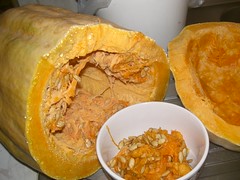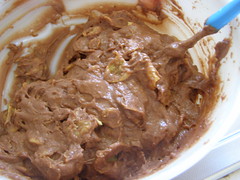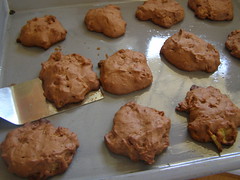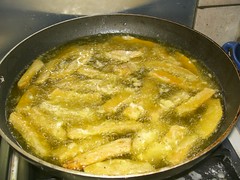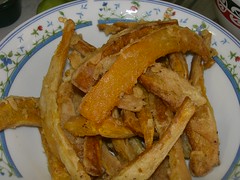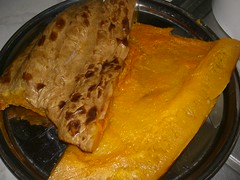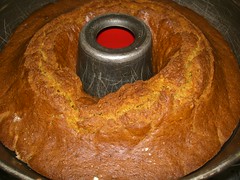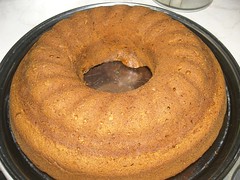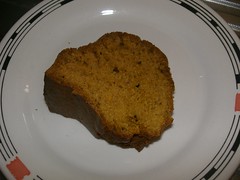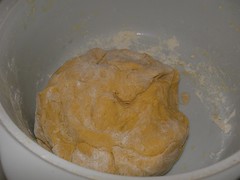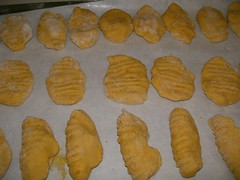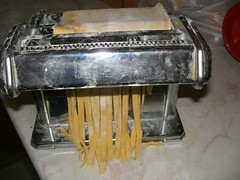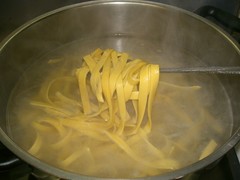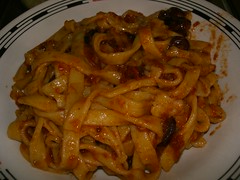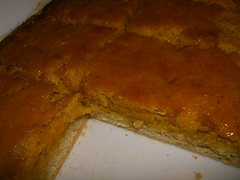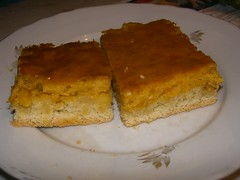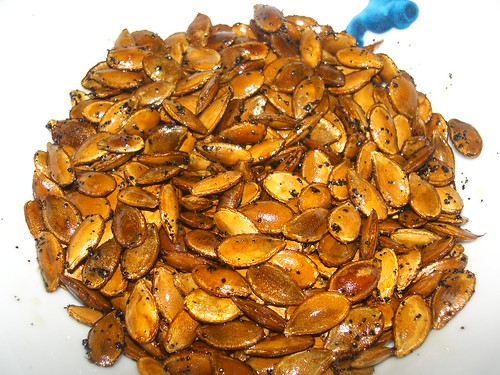Pumpkin is not really well known in Crete. It's commonly turned into sweet and savoury pies in other parts of Greece (particularly the North), but here, it's still considered an oddity by the rural community, used mainly as animal feed. My uncles' animals got their fair share of it recently, and I asked them if I could take away just one of the pumpkins lying around their farm, to turn it into something suitable for human consumption.
First, I roasted some thick large pumpkin chunks. Before they went into the oven, they sprinkled with minced garlic, seasoned with salt, pepper and cumin, and finally they were drizzled with olive oil and some water in the baking pan. When they were ready (about 30-40 minutes in a moderate oven), I doused them in a tanini and honey dressing.

The next day, I turned the leftover roast pumpkin and dressing into a tasty mash, which went well as a side dish with sausages, which I often cook when our main meal consists of mainly leftover vegetables.

In the evening, the leftovers of the leftover roast pumpkin and dressing mash was used to make a soup, thinned out by adding a few tablespoons of water and olive oil.

The following two recipes make the three dishes described above.
Apart from the roasted pumpkin pieces, all you need is some tahini dressing, which can be made in various ways. My inspiration for this dressing came from a recipe used on broccoli. Since then, I've found that this dressing can be used over cauliflower, potatoes and pumpkin.
The amount of dressing you make depends on the amount of pumpkin you roasted. For 250g pumpkin, you need:
40g tahini (about 2-3 tablespoons)
1 tbsp honey
1 tbsp wine vinegar
1 fat clove of garlic, minced
salt and pepper
Mix the ingredients together in a small sauce pan, stirring constantly over low heat, to avoid the tahini forming lumps. The mixture will be quite thick. Add some water, 1 tablespoon at a time, to make the mixture as runny as you like. The thicker, the more intense the flavour of the tahini.Serve immediately, as the tahini tends to dry out if let unused too long. It can be added all at once, or gradually as required. If any dressing is left over in the saucepan, it will need to be reheated (with some water to make it smooth.
©All Rights Reserved/Organically cooked. No part of this blog may be reproduced and/or copied by any means without prior consent from Maria Verivaki.
First, I roasted some thick large pumpkin chunks. Before they went into the oven, they sprinkled with minced garlic, seasoned with salt, pepper and cumin, and finally they were drizzled with olive oil and some water in the baking pan. When they were ready (about 30-40 minutes in a moderate oven), I doused them in a tanini and honey dressing.

The next day, I turned the leftover roast pumpkin and dressing into a tasty mash, which went well as a side dish with sausages, which I often cook when our main meal consists of mainly leftover vegetables.

In the evening, the leftovers of the leftover roast pumpkin and dressing mash was used to make a soup, thinned out by adding a few tablespoons of water and olive oil.

The following two recipes make the three dishes described above.
Apart from the roasted pumpkin pieces, all you need is some tahini dressing, which can be made in various ways. My inspiration for this dressing came from a recipe used on broccoli. Since then, I've found that this dressing can be used over cauliflower, potatoes and pumpkin.
The amount of dressing you make depends on the amount of pumpkin you roasted. For 250g pumpkin, you need:
40g tahini (about 2-3 tablespoons)
1 tbsp honey
1 tbsp wine vinegar
1 fat clove of garlic, minced
salt and pepper
Mix the ingredients together in a small sauce pan, stirring constantly over low heat, to avoid the tahini forming lumps. The mixture will be quite thick. Add some water, 1 tablespoon at a time, to make the mixture as runny as you like. The thicker, the more intense the flavour of the tahini.Serve immediately, as the tahini tends to dry out if let unused too long. It can be added all at once, or gradually as required. If any dressing is left over in the saucepan, it will need to be reheated (with some water to make it smooth.
©All Rights Reserved/Organically cooked. No part of this blog may be reproduced and/or copied by any means without prior consent from Maria Verivaki.

